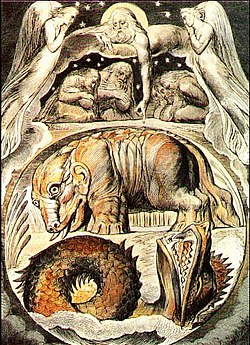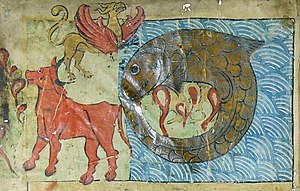Behemoth: Difference between revisions
At least keep the word mainstream. There are hundreds of scientists that do not believe in an old earth. Although the vast majority of reputable scientists are evolutionists, there is no single scientific consensus and that wording implies totality. |
Reverted 1 edit by Onceuponatime123 (talk): Hundreds does not a consensus make, read WP:FRINGE and WP:NPOV. (TW) |
||
| Line 36: | Line 36: | ||
Another opinion is that Behemoth is a product of the imagination of the author of Job, a symbol of God's power: in verse 24 he is described as having a ring ("snare") through his nose, a sign that he has been tamed by [[Yahweh]].<ref name="Metzger2004"/> |
Another opinion is that Behemoth is a product of the imagination of the author of Job, a symbol of God's power: in verse 24 he is described as having a ring ("snare") through his nose, a sign that he has been tamed by [[Yahweh]].<ref name="Metzger2004"/> |
||
Some [[Young Earth creationism|young earth creationists]] identify Behemoth as possibly a [[sauropod]] [[dinosaur]],<ref>[http://www.answersingenesis.org/articles/tj/v15/n2/behemoth Answers in Genesis: Could Behemoth Have Been a Dinosaur? by Alan K. Steel, Aug. 1, 2001]</ref><ref>[http://www.genesispark.com/genpark/bible/bible.htm Genesis Park, Room 1: The Dinosaurs]</ref><ref>{{cite web|url=http://www.answersingenesis.org/articles/am/v3/n2/dinosaurs-alive-after-babel|title=Dinosaurs—Alive After Babel?|author=Taylor, P. S.|date=February 13, 2008|work=Answers in Genesis|accessdate=February 27, 2012}}</ref> claiming that no other animal but a sauropod dinosaur has a tail that "moves like a cedar".<ref>Job 40:17</ref> The belief that the earth is less than 10,000 years old and that dinosaurs and humans lived together, however, contradicts the |
Some [[Young Earth creationism|young earth creationists]] identify Behemoth as possibly a [[sauropod]] [[dinosaur]],<ref>[http://www.answersingenesis.org/articles/tj/v15/n2/behemoth Answers in Genesis: Could Behemoth Have Been a Dinosaur? by Alan K. Steel, Aug. 1, 2001]</ref><ref>[http://www.genesispark.com/genpark/bible/bible.htm Genesis Park, Room 1: The Dinosaurs]</ref><ref>{{cite web|url=http://www.answersingenesis.org/articles/am/v3/n2/dinosaurs-alive-after-babel|title=Dinosaurs—Alive After Babel?|author=Taylor, P. S.|date=February 13, 2008|work=Answers in Genesis|accessdate=February 27, 2012}}</ref> claiming that no other animal but a sauropod dinosaur has a tail that "moves like a cedar".<ref>Job 40:17</ref> The belief that the earth is less than 10,000 years old and that dinosaurs and humans lived together, however, contradicts the scientific consensus that the earth is over four billion years old and that the last of the sauropods became [[Extinction|extinct]] about [[Cretaceous-Paleogene extinction event|65 million years ago]] when a large [[asteroid]] struck the Earth.<ref>{{cite news|title=Finally confirmed: An asteroid wiped out the dinosaurs|author=Anthony, S.|url=http://www.extremetech.com/extreme/147978-finally-confirmed-an-asteroid-wiped-out-the-dinosaurs|newspaper=ExtremeTech|date=February 8, 2013|accessdate=March 4, 2013}}</ref> |
||
==Literary references== |
==Literary references== |
||
Revision as of 22:59, 9 July 2013

Behemoth (/b[invalid input: 'ɨ']ˈhiːməθ/ or /ˈbiː.əməθ/, also /ˈbeɪ.əmɔːθ/; Hebrew בהמות, behemoth (modern: behemot)) is a beast mentioned in Job 40:15–24. Suggested identities range from dinosaur to crocodile to a mythological creature.[1] Metaphorically, the name has come to be used for any extremely large or powerful entity.
Plural as singular
Job 40 is an example of the use of a plural noun suffix to mean "great", rather than plural. The feminine plural Hebrew noun behemoth is also used in Joel 1:20.[citation needed]
Description
Job 40:15–24 describes Behemoth, and then the sea-monster Leviathan, to demonstrate to Job the futility of questioning God, who alone has created these beings and who alone can capture them.[2] Both beasts are chaos monsters destroyed by the deity at the time of creation, although such a conflict is not found in the creation account.[3]
Leviathan is identified figuratively with both the primeval sea (Job 3:8, Psalms 74:13) and in apocalyptic literature – describing the end-time – as that adversary, the Devil, from before creation who will finally be defeated. In the divine speeches in Job, Behemoth and Leviathan may both be seen as composite and mythical creatures with enormous strength, which humans like Job could not hope to control. But both are reduced to the status of divine pets, with rings through their noses and Leviathan on a leash.[4]
Behold now the behemoth that I have made with you; he eats grass like cattle.
Behold now his strength is in his loins and his power is in the navel of his belly.
His tail sways like a cedar; the sinews of his thighs are knit together.
His limbs are as strong as copper, his bones as a load of iron.
His is the first of God's ways; only his Maker can draw His sword.
For the mountains bear food for him, and all the beasts of the field play there.
Does he lie under the shadows, in the cover of the reeds and the swamp?
Do the shadows cover him as his shadow? Do the willows of the brook surround him?
Behold, he plunders the river, and does not harden; he trusts that he will draw the Jordan into his mouth.
With His eyes He will take him; with snares He will puncture his nostrils.
Later Jewish writings
In Jewish apocrypha and pseudepigrapha such as the 2nd century BCE Book of Enoch, Behemoth is the primal unconquerable monster of the land, as Leviathan is the primal monster of the waters of the sea and Ziz the primordial monster of the sky. According to this text Leviathan lives in "the Abyss", while Behemoth the land-monster lives in an invisible desert east of the Garden of Eden (1 Enoch 60:7–8). A Jewish rabbinic legend describes a great battle which will take place between them at the end of time: "...they will interlock with one another and engage in combat, with his horns the Behemoth will gore with strength, the fish [Leviathan] will leap to meet him with his fins, with power. Their Creator will approach them with his mighty sword [and slay them both]." Then, "from the beautiful skin of the Leviathan, God will construct canopies to shelter the righteous, who will eat the meat of the Behemoth and the Leviathan amid great joy and merriment." (Artscroll siddur, p. 719).
Identity

Since the 17th century CE there have been many attempts to identify Behemoth. Some scholars have seen him as a real creature, usually the hippopotamus, occasionally the elephant, crocodile, or water buffalo.[2] The reference to Behemoth's "tail" that "moves like a cedar" presents a problem for most of these readings, since it cannot easily be identified with the tail of any animal. Biologist Michael Bright suggests that the reference to the cedar tree actually refers to the brush-like shape of its branches, which resemble the tails of modern elephants and hippopotamuses.[5] Some have identified the cedar as an elephant trunk, but it might instead refer to Behemoth's penis, since the Hebrew word for "move" can also mean "extend", and the second part of the verse speaks of the sinew around his "stones" (not, as in the translation provided above, his "thighs"). The Vulgate seems to endorse such a reading by using the word "testiculorum".[6]
Another opinion is that Behemoth is a product of the imagination of the author of Job, a symbol of God's power: in verse 24 he is described as having a ring ("snare") through his nose, a sign that he has been tamed by Yahweh.[1]
Some young earth creationists identify Behemoth as possibly a sauropod dinosaur,[7][8][9] claiming that no other animal but a sauropod dinosaur has a tail that "moves like a cedar".[10] The belief that the earth is less than 10,000 years old and that dinosaurs and humans lived together, however, contradicts the scientific consensus that the earth is over four billion years old and that the last of the sauropods became extinct about 65 million years ago when a large asteroid struck the Earth.[11]
Literary references
Classicist philosopher Thomas Hobbes named the Long Parliament as Behemoth in his book Behemoth. It accompanies his book of political theory that draws on the lessons of English Civil War, the rather more famous Leviathan. It is also the name of a character in Mikhail Bulgakov's novel, The Master and Margarita.[citation needed]
He also appears in John Milton’s Paradise Lost (Book VII 470–472): "[… ]Scarce from his mould / Behemoth biggest born of earth upheaved / His vastness: Fleeced the flocks and bleating rose,[ …]"
The Behemoth is mentioned in The Seasons by James Thomson: "[…] behold ! in plaited mail / Behemoth rears his head." […] (Summer). The German émigré Franz Leopold Neumann entitled his 1941 book about National Socialism, Behemoth: The Structure and Practice of National Socialism.
The Behemoth is also mentioned in the opera, Nixon in China, composed by John Adams, and written by Alice Goodman. At the beginning of the first act, the chorus sings "The people are the heroes now, Behemoth pulls the peasants' plow" several times.[citation needed]
See also
Notes
- ^ a b Metzger, Bruce Manning; Coogan, Michael D (2004). The Oxford Guide To People And Places Of The Bible. Oxford University Press. p. 33. ISBN 978-0-19-517610-0. Retrieved 22 December 2012.
- ^ a b Van Der Toorn, Karel; Becking, Bob; Van Der Horst, Pieter W (1999). Dictionary of Deities and Demons in the Bible: Second Extensively Revised Edition. Brill. pp. 165–168. ISBN 978-90-04-11119-6.
- ^ Iwanski, Darius (2006). The dynamics of Job's intercession. Biblical Institute Press. p. 41. ISBN 978-88-7653-161-3.
- ^ Michael D. Coogan, "A Brief Introduction to the Old Testament" Page 387
- ^ Bright, Michael (2006). Beasts of the Field: The Revealing Natural History of Animals in the Bible. London: Robson. pp. 26–27. ISBN 1-86105-831-4.
- ^ Mitchell (1987)
- ^ Answers in Genesis: Could Behemoth Have Been a Dinosaur? by Alan K. Steel, Aug. 1, 2001
- ^ Genesis Park, Room 1: The Dinosaurs
- ^ Taylor, P. S. (February 13, 2008). "Dinosaurs—Alive After Babel?". Answers in Genesis. Retrieved February 27, 2012.
- ^ Job 40:17
- ^ Anthony, S. (February 8, 2013). "Finally confirmed: An asteroid wiped out the dinosaurs". ExtremeTech. Retrieved March 4, 2013.
References
- Metzeger, Bruce M. (ed) (1993). The Oxford Companion to the Bible. Oxford, UK: Oxford University Press. ISBN 0-19-504645-5.
{{cite book}}:|first=has generic name (help); Unknown parameter|coauthors=ignored (|author=suggested) (help) - Mitchell, Stephen, 1987. The Book of Job. San Francisco: North Point Press. Cited in R. T. Pennock, 1999, Tower of Babel, Cambridge, MA: MIT Press.
External links
- Leviathan and Behemoth article in the Jewish Encyclopedia
- Putting God on Trial – The Biblical Book of Job contains a major section on the literary use of Behemoth.
